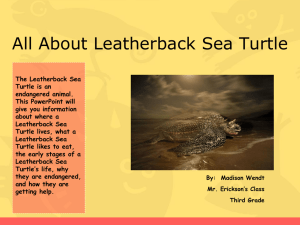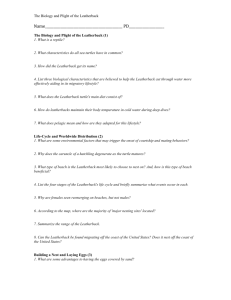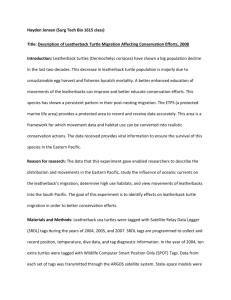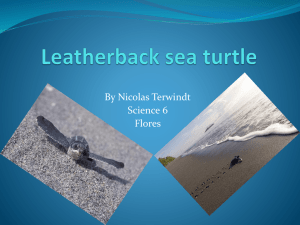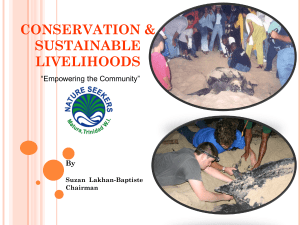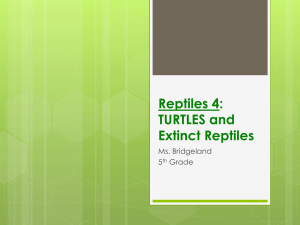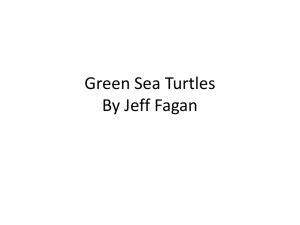Leatherback Sea Turtles
advertisement
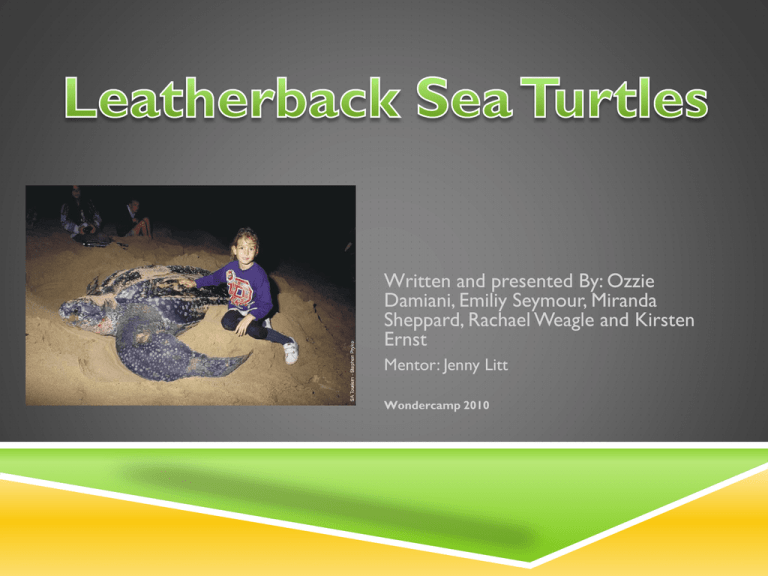
Written and presented By: Ozzie Damiani, Emiliy Seymour, Miranda Sheppard, Rachael Weagle and Kirsten Ernst Mentor: Jenny Litt Wondercamp 2010 COASTLINES coast·line- the land and water lying adjacent to a shoreline. People are concerned about the effects of water on the land of our coasts , eroding away our worlds landscape but another thing at risk is the marine life that live in those waters, especially sea turtles, like the leatherback sea turtle. ABOUT THE LEATHER BACK TURTLE The Leatherback turtle is the largest turtle in the world! An average adult leatherback is 4 to 8 feet long, and 500 to 2000 pounds in weight. The leatherback turtle gets its name from its covering on its back being a carapace, a much weaker, leather type material that sits in place of a shell. 30 years ago, there were about 115000 female leatherback turtles that would lay their eggs a year. Today, only about 26 000 female leatherbacks lay eggs per year. (www.fws.gov) http://www.bing.com/videos/search?q=leatherb ack+turtle+nesting+on+beach&docid=1332131 27847&mid=791C9C774D5FEC46D08C791C 9C774D5FEC46D08C&FORM=LKVR8# ABOUT THE LEATHERBACK TURTLE This particular breed of turtle has been around for more then 100 000 000 years! Leatherback turtles can be found swimming practically anywhere in the world, swimming as far north as Nunavut and Russia, or as southern as Australia and Cape Horn, Argentina It is one of the few remaining sea turtles that swims around our province of Nova Scotia. NESTING SPOTS Red dots-major nesting locations Yellow dots- minor nesting locations Leatherback turtles nest along the coast of Mexico, Costa Rica, Puerto Rico, Malaysia, Columbia, Indonesia, U.S Virgin Islands and Florida.They dig holes to settle into, and then lay their eggs. NESTING OF THE LEATHERBACK TURTLE •Throughout the world where leatherback turtles nest, people eat their eggs. •Many nests are lost to predators like dogs and humans. •Because leatherback turtles nest on beaches, like all species of sea turtles, sometimes these are destroyed by coastal development because human beings also want to live and play on these same beaches. •Leatherback turtle beaches are affected by dredging, ship, small boat traffic and construction. Bright lights and pollution http://www.sprep.org/factsheets/le atherbacks/index.htm Explains that each year most of the babies don’t even make it to the water from these activities disrupts nesting behavior and confuses hatchlings when they emerge from the nest, often resulting in a high number of deaths. HUMAN EFFECTS ON THE LEATHERBACK TURTLES. Due to human and fisheries effect on the leatherback turtles 80-95% of their population has died over the past 20 years Approximately one thousand leatherbacks die every year by fishing nests and other gear. Coastal development can destroy and has degraded leatherback habitat therefore they cannot nest and no hatchlings will be born, some of the costal developments that cause this are jetties, sea walls, hotels and houses. Human alterations to the beach can drive the turtles away so they will not nest, therefore the population cannot increase. When plastic bags are placed into the water where a leatherback is living it may mistake the bag as a jelly fish and will try to ingest it and it can cause it to die, there for to help save these turtles we need to not pollution into the waters. http://www.sprep.org/factsheets/leatherbacks/index.htm ship and small boat traffic They die from drowning, caused by getting caught in fishing nets or fishing lines. Pollution like plastics, old fishing gear and other garbage can lead to death of leatherbacks if the ingest it or get tangled into it. Chemical pollutants or oil can cause weakness and make it easier for them to attract diseases. http://www.sprep.org/factsheets/leatherbacks/ind ex.htm http://www.conservation.org/learn/biodiversity/species/profiles/turtles/ sea_turtles/leatherback/Pages/threats.aspx TEMPERATURES CHANGING: A MAJOR EFFECT!! Lately, the temperatures have significantly been rising, including the ocean temperature and sand. If the temperature reaches a peek of 91 degrees Fahrenheit or 31 degrees Celsius, the leatherback turtle’s eggs can die, leaving a much lower population. The hatching season can also be effected. If the temperature rises, which it has been, there will be a less population of male turtles compared to the number of females. http://news.discovery.com/animals/sea-turtles-global-warming.html http://www.iucn.org/about/work/programmes/species/our_work/climate_change_and_species/species_and_climate_change_more_than_just_the_polar_bear/ INCREASE IN THE NUMBER OF FEROCIOUS STORMS: When a storm such as a hurricane, tsunami or cyclone hits a coastline, it can erode part it away. This causes: Eggs being washed away, a less population. Changes in when hatchlings are born: more females compared to males. http://www.sprep.org/factsheets/leatherbacks/index.htm THE IMPACT OF RISING SEA LEVELS Sea Levels have risen approximately 1.8mm per year ever since 1961. This will continue, slow but at a steady pace. As sea levels rise, and come ashore, shorelines and beaches, it erodes, loss of eggs. There is less of a habitat spot for the leatherback turtles to go to. Sea Walls don’t help, when referred to the turtle as they reduce the number of habitation spots for them. http://cmsdata.iucn.org/downloads/fact_sheet_red_list_turtle.pdf THE IMPORTANCE OF LEATHER BACK TURTLES ON THE OCEAN'S ECOSYSTEMS. Q: Are leather back turtles really important to the ocean’s ecosystem? Q: What role do they play in the ocean’s ecosystem? Q: What would happen if these turtles became extinct? THE IMPORTANCE OF LEATHERBACK TURTLES ON THE OCEAN’S ECOSYSTEM. These turtles bind all of the organism together specifically through the food chain. They feed on certain plants and microscopic organisms therefore controlling their population. Some of the species that they consume are very invasive. They could over populate in coral reefs. After a short amount of time they could destroy the coral reefs. These reefs support millions of species of marine animals and plants. Therefore with the coral reefs gone many of these species would have a huge risk of becoming endangered or extinct. THE IMPORTANCE OF LEATHERBACK TURTLES IN THE OCEAN’S ECOSYSTEM. Healthy coral reefs. The leather back turtle feeds on invasive plants. Keeping the coral reef controlled and healthy. THE IMPORTANCE OF LEATHERBACK TURTLES ON THE OCEAN’S ECOSYSTEM. Unhealthy or destroyed coral reefs. With a reduced number or extinction of leather back turtles the coral reefs can no longer thrive. Invasive plants will start to take over the reef. THE IMPORTANCE OF LEATHERBACK TURTLES ON THE OCEAN’S ECOSYSTEM. Leatherback turtles are very important to the earths biodiversity as well as the ocean’s ecosystem. If there was an absence (extinction) of these turtles it could have a disastrous effect. THE SOLUTION! If a leatherback turtle lays it’s eggs on a populated beach, a barrier should be constructed around the nest. There should be a small opening for them to get out once they are hatched. THE SOLUTION! In the case that a leatherback sea turtle lays it’s eggs on a particular shoreline there should be a phone number or hotline that you can call to report the eggs so that they can be isolated. THE SOLUTION! To slow coastal eroding we could stop developing near the shoreline. THE SOLUTION! Another way to help coastal erosion would be beach replenishment and nourishment. Beach replenishment http://www.nytimes.com/2009/03/08/nyregion/newjersey/08beachnj.html?_r=1 THE SOLUTION! Other small ways we can make a difference are: Do not litter along the shorelines. Turn off your outside lights at night. Watch out for sea turtle eggs on the beaches. If you see old fishing nets please dispose of them. Pick up litter along the shoreline.
